Continuing on from GM’s vintage men’s watch guide is a bit of history about one specific men’s vintage watch featured in the TV show Mad Men: the Bulova Accutron
If there’s one men’s wristwatch that captured the spirit of the 1960s, it was the Bulova Accutron.
Accutron was a combination of ‘accurate’ and ‘electronic’, making it the perfect name for an electronic watch that was certified to be accurate to within a single second a month. Such timekeeping accuracy was simply unheard of on the eve of the watch’s public unveiling towards the end of 1960.
Bulova’s promised accuracy was down to a new type of watch movement, called the tuning fork, designed by electronics engineer Max Hetzel. What’s more, rather than ticking like regular mechanical watches of the time, the Accutron hummed.
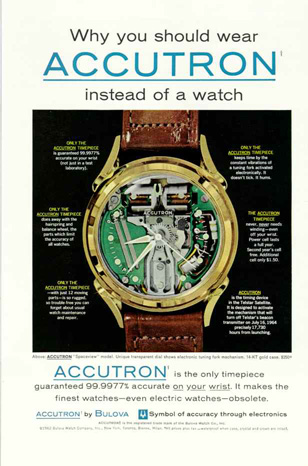
In the advertising, Bulova didn’t refer to the Accutron as being a watch, almost as if the Accutron was a new device to replace all watches.
The Bulova Accutron was a truly revolutionary product. Like most new technology and gadgets that are first released, the Accutron wasn’t a cheap item. In fact, it cost as much as a Rolex.
Accutron: Our Only Mistake Was To Make It Look Like A Watch
The most famous Accutron model was the Spaceview which had no dial, with the watches innards completely on show. Like a lot of things in life, it came about completely by accident and was never actually intended for sale. You see, keen to create excitement and explain how the new technology powered the Accutron, display models were sent to Bulova dealers with the tuning fork movement on display. The public were immediately drawn to these strange and unique timepieces in the shop window, so rather than wanting to buy one with a dial, they asked the salesman for the unusual watch on display. Of course, salesmen being salesmen, they didn’t want to miss out on a chance for commission so willingly sold them off.
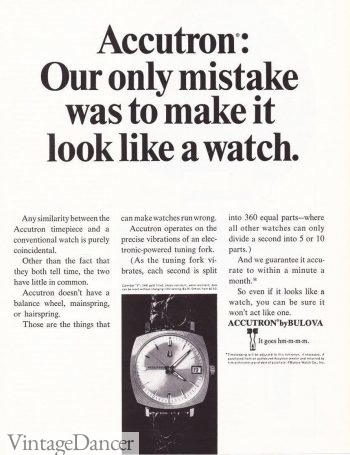
Soon, dealers everywhere were contacting Bulova asking for more Accutrons with no dials. Dealers even resorted to removing the dials from the ordinary Accutrons that they had in stock as they struggled to keep up with demand from the public, keen to show it off to their friends.
In response, Bulova added the ‘Spaceview’ to the Accutron line, along with other popular models including the Astronaut (a GMT watch, perfect for jet setters) and the Railroad Approved (which railworkers used to synchronise trains).
While the original Accutrons came in a 14k gold watch case, the new models were produced in cheaper stainless steel and filled gold. The new purpose-built Spaceviews also came with a chapter ring (a built-in metal minute scale running around the inside of the watch face) and the crystal had the Accutron name and tuning fork logo printed straight onto it.
The Power Behind The Anti-Tick Movement
Bulova didn’t produce the first electronic watch. That honor goes to Hamilton, with their Ventura model. To cement the Hamilton Ventura’s iconic status, this highly distinctive watch was famously worn by Elvis Presley in 1961 movie, Blue Hawaii.
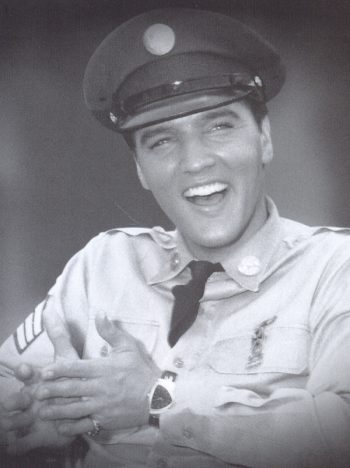
Elvis wearing a 1957 Hamilton Ventura watch. Buy One on ebay
Bulova can claim a first though as the Accutron was the first electronic watch to be controlled by a transistor.
A watch’s accuracy is determined by how fast it’s time base element moves. When the Accutron was released to much fanfare in 1960, the most accurate mechanical watches (watches that you wind-up), had a frequency of 2Hz (beats a second). In comparison, the Accutron had a frequency of 360Hz, which quite frankly, was astonishing technology.
The undoubted star of the Accutron was the tiny tuning fork. Two small electric coils, visible at the top of the Spaceview, were placed on either side, which in turn created an electric field that made the tuning fork vibrate. The vibration then moved a ratchet which pushed the watch hands forward. The Accutron’s second hand moved forward in 360 increments per second, giving it a lovely sweeping movement, rather than the ‘tick, tick’ movement that we are so used to seeing today in quartz powered watches.
Clever Watch Design
I absolutely love the look of the early Bulova Accutron models. If possible, I would love to have two versions – one with a dial such as the Railroad Approved and the more futuristic looking Spaceview.
What immediately made the Accutron 214s stand out anyway, regardless of dial preference, was the lack of the crown at the side of the watch. This gave the watch a perfectly smooth shape, which I personally find very pleasing on the eye. As you would expect, this was a deliberate decision by Bulova to show that the Accutron was so precise that it didn’t need to be set.
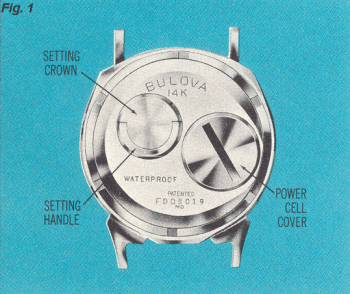
Accutron Series 214
The crown, which adjusts the time of the watch, was actually hidden at the back, along with a battery port. This was clever design work by Bulova. To adjust the time of the watch, you would use a finger nail or a coin (the watch actually came with a special Bulova coin) to lift up the setting handle. You would then simply turn the handle to change the time.
A Conversation Piece
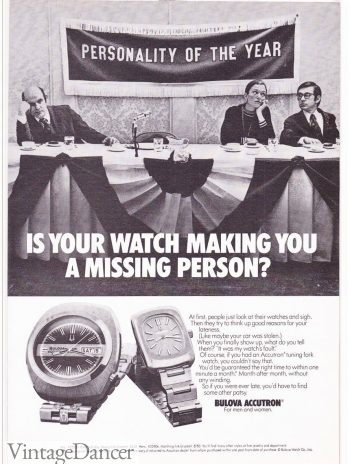
1967 Ad for Bulova Accutron
It’s fair to say that Bulova were true leaders when it came to advertising their watches. Not only did they produce America’s first national radio commercial in the 1920s with the slogan ‘It’s 8am, Bulova Time’, but they also had the first legal television commercial in 1941.
As well as exploiting television and radio, Bulova also produced some of the most iconic print advertisements of the time. I love their slogans, with this one probably being my favorite – ‘all the parts that make a watch fast or slow have been left out’.
It’s for this reason that it was a perfect fit to have the Bulova Accutron featured in season 7, episode 1 of Mad Men.
The scene is a monologue by ad-man, Freddy Rumsen, who is running through a new Bulova pitch for Peggy Olson. It really captures the brand perfectly, showing the Accutron as a ‘conversation piece’, giving the customer a reason to possess this watch, rather than just using it for its basic function to tell the time.
Own A Piece Of American History
Although Bulova is now owned by Japanese brand, Citizen, Bulova was once a solid American watch company that Americans were proud to own. The Accutron was a watch that perfectly exemplifies Bulova’s forward-thinking and leading example in the watch world.
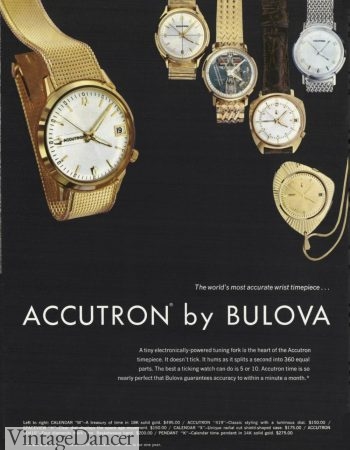
1968 Ad
Vintage Bulova Accutrons with the tuning fork movement was made from 1960 to 1977, bridging the gap between mechanical and automatic watches to the domination of quartz.
If you’d like to own a real piece of American history, vintage models are still widely available on eBay and other second-hand dealers. If you’re interested in buying a Spaceview though, be careful that you’re getting an original as there are a lot of Accutrons that have been made to look like a Spaceview, as this is the most desired watch in the Accutron line.
Debbie Sessions has been teaching fashion history and helping people dress for vintage themed events since 2009. She has turned a hobby into VintageDancer.com with hundreds of well researched articles and hand picked links to vintage inspired clothing online. She aims to make dressing accurately (or not) an affordable option for all. Oh, and she dances too.